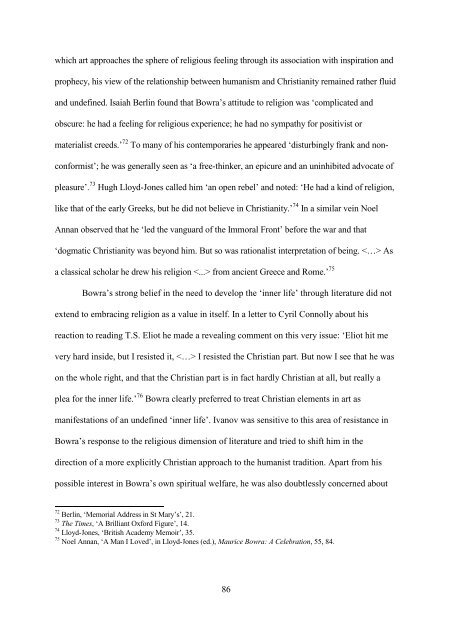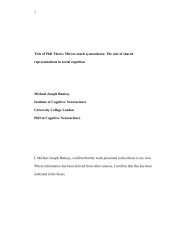Vyacheslav Ivanov and C.M. Bowra: a ... - UCL Discovery
Vyacheslav Ivanov and C.M. Bowra: a ... - UCL Discovery
Vyacheslav Ivanov and C.M. Bowra: a ... - UCL Discovery
You also want an ePaper? Increase the reach of your titles
YUMPU automatically turns print PDFs into web optimized ePapers that Google loves.
which art approaches the sphere of religious feeling through its association with inspiration <strong>and</strong><br />
prophecy, his view of the relationship between humanism <strong>and</strong> Christianity remained rather fluid<br />
<strong>and</strong> undefined. Isaiah Berlin found that <strong>Bowra</strong>’s attitude to religion was ‘complicated <strong>and</strong><br />
obscure: he had a feeling for religious experience; he had no sympathy for positivist or<br />
materialist creeds.’ 72 To many of his contemporaries he appeared ‘disturbingly frank <strong>and</strong> non-<br />
conformist’; he was generally seen as ‘a free-thinker, an epicure <strong>and</strong> an uninhibited advocate of<br />
pleasure’. 73 Hugh Lloyd-Jones called him ‘an open rebel’ <strong>and</strong> noted: ‘He had a kind of religion,<br />
like that of the early Greeks, but he did not believe in Christianity.’ 74 In a similar vein Noel<br />
Annan observed that he ‘led the vanguard of the Immoral Front’ before the war <strong>and</strong> that<br />
‘dogmatic Christianity was beyond him. But so was rationalist interpretation of being. As<br />
a classical scholar he drew his religion from ancient Greece <strong>and</strong> Rome.’ 75<br />
<strong>Bowra</strong>’s strong belief in the need to develop the ‘inner life’ through literature did not<br />
extend to embracing religion as a value in itself. In a letter to Cyril Connolly about his<br />
reaction to reading T.S. Eliot he made a revealing comment on this very issue: ‘Eliot hit me<br />
very hard inside, but I resisted it, I resisted the Christian part. But now I see that he was<br />
on the whole right, <strong>and</strong> that the Christian part is in fact hardly Christian at all, but really a<br />
plea for the inner life.’ 76 <strong>Bowra</strong> clearly preferred to treat Christian elements in art as<br />
manifestations of an undefined ‘inner life’. <strong>Ivanov</strong> was sensitive to this area of resistance in<br />
<strong>Bowra</strong>’s response to the religious dimension of literature <strong>and</strong> tried to shift him in the<br />
direction of a more explicitly Christian approach to the humanist tradition. Apart from his<br />
possible interest in <strong>Bowra</strong>’s own spiritual welfare, he was also doubtlessly concerned about<br />
72 Berlin, ‘Memorial Address in St Mary’s’, 21.<br />
73 The Times, ‘A Brilliant Oxford Figure’, 14.<br />
74 Lloyd-Jones, ‘British Academy Memoir’, 35.<br />
75 Noel Annan, ‘A Man I Loved’, in Lloyd-Jones (ed.), Maurice <strong>Bowra</strong>: A Celebration, 55, 84.<br />
86
















